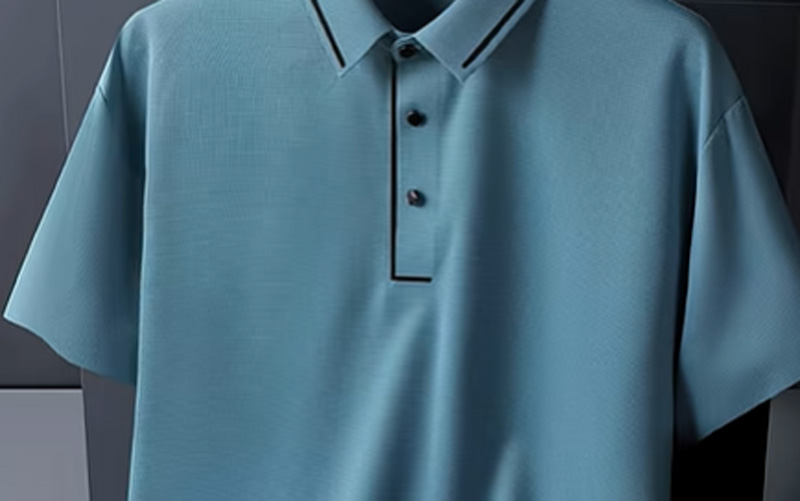In the competitive world of sportswear and casual fashion, polo shirts have remained a timeless staple due to their versatile look and comfort. However, the quality and finish of a polo shirt depend significantly on the placket—the front opening that often includes buttons and defines the shirt’s structure and appearance. With evolving consumer demand for comfort, durability, and minimalistic aesthetics, manufacturers are increasingly adopting ultrasonic placket cutting machines to produce seamless polo shirts.
In this blog, we will explore why ultrasonic placket cutting is the future of polo shirt production, how the technology works, and the key advantages it brings to apparel manufacturers aiming to stay competitive in a fast-paced market.

1. What is a Placket and Why Does It Matter in Polo Shirts?
The placket is the vertical opening on the front of a polo shirt, often finished with buttons or snaps. It not only facilitates ease of wear but also serves as a defining aesthetic element.
A poorly constructed placket can ruin the shirt’s appearance, cause discomfort, or degrade after repeated washes. Traditionally, plackets are sewn using multiple stitches, which can leave visible seams, frayed edges, or puckering—especially in lightweight or stretchy fabrics.
That’s where ultrasonic placket cutting machines come in: they replace stitching with seamless, heat-sealed cuts using ultrasonic energy.
2. What is an Ultrasonic Placket Cutting Machine?
An ultrasonic placket cutting machine uses high-frequency mechanical vibration (typically 20–35 kHz) to generate localized heat that cuts and seals synthetic or blended fabric simultaneously. This process is contactless and blade-free, meaning it doesn’t rely on frictional cutting like traditional blades or sewing machines.
The result? Smooth, burr-free, sealed edges with no burning, blackening, or fraying—ideal for achieving a seamless finish on polo shirt plackets.
3. Why Use Ultrasonic Cutting for Polo Shirts?
Polo shirts are often made of polyester, nylon, or synthetic blends with stretch properties. These fabrics are excellent candidates for ultrasonic processing because:
They melt slightly under ultrasonic vibration, sealing the cut edge.
They don’t require reinforcement stitching when properly sealed.
The fabric’s surface remains smooth and clean post-processing.
For fashion-forward, performance-oriented, or minimalistic polo shirts, ultrasonic cutting helps achieve a refined and futuristic look.
4. How Does the Ultrasonic Cutting Process Work?
Here’s a simplified breakdown of how the ultrasonic placket cutting machine operates:
🔹 Step 1: Fabric Feeding
Fabric is manually or automatically positioned under the machine head, where the placket area is to be cut.
🔹 Step 2: Clamping
A pneumatic press foot holds the fabric in place to avoid shifting during processing.
🔹 Step 3: Ultrasonic Vibration
The machine’s horn vibrates at ultrasonic frequency, creating localized heat through friction at the molecular level.
🔹 Step 4: Cutting and Sealing
The vibrating horn cuts through the fabric, melting the edges instantly to create a sealed, smooth line—no separate sealing required.
🔹 Step 5: Finished Placket
The result is a clean, seamless placket with a durable edge that maintains shape and structure after multiple washes.
5. Applications of Ultrasonic Placket Cutting in Polo Shirt Manufacturing
Ultrasonic technology can be applied in various stages of polo shirt production, including:
✅ Front Placket Cutting
Replacing traditional knife or laser cutters for precise front placket formation.
✅ Button Hole Area Sealing
Creating reinforced zones where buttons or snaps are attached—avoiding overstitching.
✅ Edge Finishing
Smoothing out hems or transitions around the collar or sleeve openings.
✅ Decorative Seamless Designs
Using ultrasonic energy to create unique patterns, fold lines, or structured effects in modern minimal-style polo shirts.
6. Benefits of Using Ultrasonic Cutting for Polo Shirts
🔸 1. No Stitch Marks or Seams
The seamless edge is visually clean, with no needle holes, threads, or overlapping fabric. Perfect for modern minimalist or luxury sportswear lines.
🔸 2. Zero Fraying
Unlike mechanical cutting, ultrasonic cutting seals synthetic fibers as it slices—completely preventing fraying.
🔸 3. No Discoloration or Burn Marks
When tuned correctly, ultrasonic cutters cause no blackening or melting damage—even on delicate or thin fabrics.
🔸 4. Enhanced Comfort
No bulky seams or folded fabric edges rubbing against the skin. Ideal for performance wear and long-term comfort.
🔸 5. Faster Production Times
Since the process combines cutting and sealing in one step, production time is significantly reduced.
🔸 6. Reduced Labor Costs
No need for manual sealing, edge stitching, or excessive QC checks—simplifying the workflow.
🔸 7. Increased Durability
Sealed plackets last longer in industrial washing conditions, making them perfect for uniforms, school wear, and activewear.
7. Case Study: Seamless Polo Shirt Production with Ultrasonic Cutting
Let’s say a mid-size sportswear brand switches to ultrasonic cutting machines to improve the quality of their active polo line. Here’s how they benefit:
| Process | Before (Traditional) | After (Ultrasonic Cutting) |
|---|---|---|
| Cutting Time per Unit | 25–30 seconds | 10–15 seconds |
| Labor Needed | 2 operators per line | 1 operator per line |
| Edge Quality | Sewn, visible seams | Seamless, sealed edge |
| Defect Rate | 5% (fraying, misalignment) | <1% |
| Aesthetic Quality | Acceptable | Premium |
The brand not only improved production efficiency by over 40% but also elevated the perceived value of its garments, allowing them to raise prices and enter new premium retail channels.
8. Things to Consider Before Investing
🔹 Fabric Compatibility
Ultrasonic cutting is best suited for synthetic fibers such as polyester, nylon, acrylic, or blends. Pure cotton does not melt under vibration and will require other sealing methods.
🔹 Machine Tuning
Frequency and pressure settings must be optimized for different fabric weights and finishes. Overheating or incorrect tuning can cause tearing or deformation.
🔹 Operator Training
Although the machine is semi-automatic, operator knowledge of fabric handling and setting adjustments is essential for consistent output.
🔹 Maintenance
The ultrasonic horn and transducer need regular cleaning and occasional calibration to maintain performance.
9. Eco-Friendly Advantages of Ultrasonic Cutting
No Need for Threads, Glues, or Chemicals
No Emission of Harmful Gases or Residue
Low Energy Consumption
Waste Reduction through precise and clean edge cutting
For brands looking to go green or achieve sustainability certifications, ultrasonic technology supports eco-friendly production goals.
10. Future Trends: Ultrasonic Cutting in Fashion-Tech
The integration of ultrasonic cutting with automation, AI pattern detection, and robotic garment assembly is on the rise. Brands are also exploring:
CAD-to-Machine Integration for digital placket pattern transfer.
Modular ultrasonic units that can handle buttonholes, plackets, and collar cuts in one line.
Smart sensors to auto-adjust pressure and frequency in real time, improving adaptability to new fabric types.
As athleisure, techwear, and minimalist fashion continue to dominate the apparel market, ultrasonic placket cutting will be a standard in future-ready production lines.
Conclusion
The ultrasonic placket cutting machine represents a significant leap in garment manufacturing technology, especially for high-performance and seamless apparel like polo shirts. It enables manufacturers to achieve a clean, modern look with increased durability and comfort while also enhancing production efficiency and sustainability.
Whether you’re a garment brand looking to innovate, a factory manager aiming to streamline operations, or a designer focused on minimalism and quality, ultrasonic cutting technology is your competitive edge.
If your business involves the mass production of polo shirts, now is the perfect time to explore how ultrasonic placket cutting machines can redefine your product quality and manufacturing process. Contact Alster to get price of this machine!
